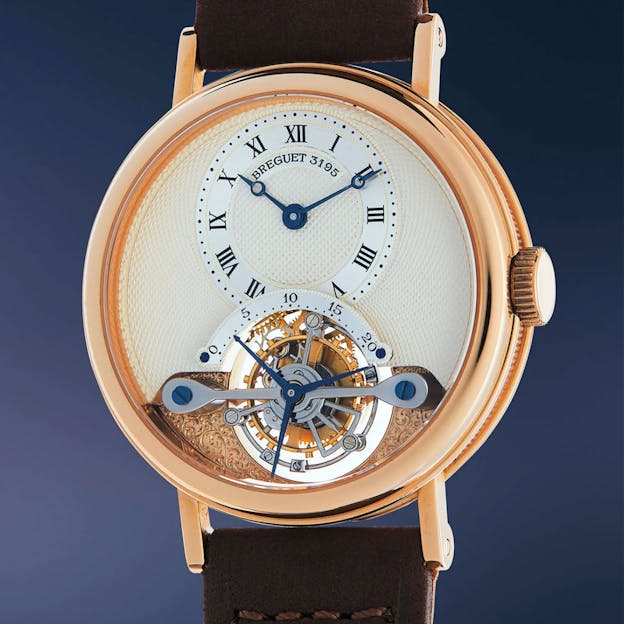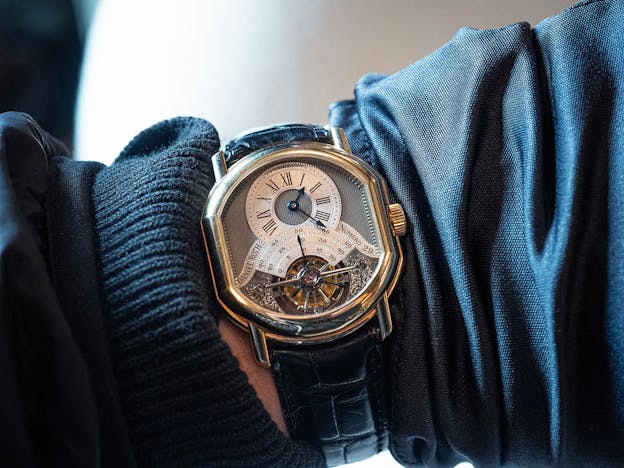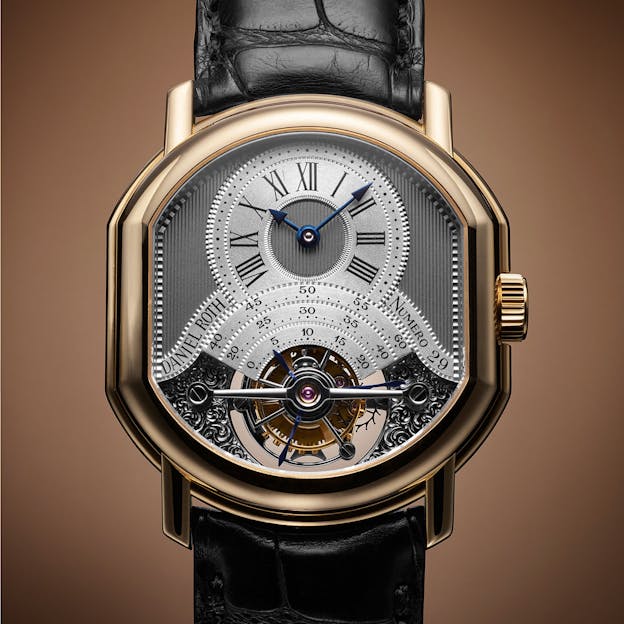Louis Vuitton Debuts Daniel Roth Souscription Tourbillon At LVMH Watch Week
The render becomes reality.
The process of reviving a dormant, or even defunct, brand is one that offers a great deal of potential (depending to some extent on the brand) but which also offers a lot of potential pitfalls. Over the last dozen or so years we’ve seen announcements of the relaunch of brands as varied as Nivada Grenchen, Vulcain, and of course most recently, Universal Genève, but two of the most high profile revivals, have been Gérald Genta and Daniel Roth. Both brands had been of course, launched by their eponymous founders; both had been, through various vagaries of fate, eventually found themselves owned by Bulgari and both have now been spun off as independent brands in the Louis Vuitton watch brand stable, under the supervision of Jean Arnault, director of marketing and development for Louis Vuitton’s watch division.
Daniel Roth, who is now nearing 80, was a key figure in the history of modern tourbillon wristwatches, thanks to his involvement with Breguet, which began in 1975 after the venerable company was acquired by the Paris-based Chaumet brothers, who were determined to restore the company to something of the glory it had enjoyed under its founder. Essential to this revival was the re-introduction of the tourbillon (for obvious reasons; Breguet is well known as the inventor of the tourbillon) and Roth, who joined Breguet in 1975, was responsible for developing some of Breguet’s first tourbillon wristwatches, including its first – the reference 3550. Unfortunately the brand failed to thrive with the Chaumet brothers at the helm, and it was sold to Investcorp in 1988.

Daniel Roth struck out on his own, and began producing a series of extremely high grade watches which compared favorably or better in fit, finish and general execution to anything being produced in Switzerland or elsewhere at the time, and one of his most famous tourbillons – as well as his first watch – was the C187.

The C187, like the Breguet 3550, had a movement produced by Lemania in collaboration with Daniel Roth (it is sort of amazing given the fact that almost nobody thinks of Lemania as anything other than a maker of chronograph movements, that they made complicated movements up to and including repeaters and tourbillons). This was the Lemania 387, which Roth developed in collaboration with Lemania and Breguet’s then-director, François Bodet. Roth’s version, like Breguet’s, placed the one minute tourbillon front and center, with a triple arc track for the running seconds and three seconds hands of different lengths mounted on the tourbillon cage upper pivot. This is a most ingenious and even slightly theatrical solution to using a one minute tourbillon for a running seconds.

In March of 2023, Louis Vuitton presented a sort of virtual preview of the first watch that the newly revived Daniel Roth brand would launch. The watch is the “Souscription” tourbillon. The name refers to the fact that the watch, which is a limited edition of 20 pieces, is being sold on a subscription basis, in which clients are invited to pay 50% of the price as a downpayment, with the balance payable on delivery (a system perhaps most famously used by Breguet, for his “Souscription” pocket watches). When the project was introduced, we were shown renderings of an almost-finalized design, which was largely a faithful relaunch not just of the Daniel Roth brand, but of the C187 tourbillon as well.

This week, Daniel Roth has presented the first prototype, which, while it is generally almost identical to the design presented nearly a year ago, has had some subtle but significant adjustements as well.
The New 2024 Prototype
The new version uses the same double ellipse case as shown in the design render, and as used by Daniel Roth in the original C187 tourbillon.

This includes the use of the triple-arc seconds tracks, the three varying-length seconds hands, and a one-minute tourbillon under a bar-shaped bridge, visible from the dial side of the watch. The complex case shape has been retained, although as was seen in the March 2023 design rendering, the lugs are now curved rather than straight. The complex arrangement of guilloché patterns is as seen in the original design, with the various layers of the dial and movement providing the same sense of depth and visual drama seen in the original C187.

But there have been some changes as well. The sans-serif typeface used in the design rendering has been replaced with a serif typeface much closer to that used in the original. The Arabic numerals on the minute track arcs are now more traditionally rendered, and the Roman numerals for the hours now have upper and lower serifs as well, bringing the whole design of the prototype more in line with the original C187. The crown now has a slightly more rounded profile, and is marked with a double ellipse outline.

As with the original, the Souscription has a solid caseback. The movement, caliber DR001, is a shaped tourbillon caliber, running at 21,600 vph in 19 jewels, with an 80 hour power reserve, and although it’s not visible to the owner, the layout is a beautiful, logical, classical execution of a traditional tourbillon going train. The mainspring barrel is at 12:00, with the center and third wheels below, and the third wheel (under a black-polished steel cock) drives the pinion of the tourbillon carriage. The transition between the upper barrel bridge and lower train bridge has been very attractively handled, and there are several well executed sharp interior angles. It’s a great example of what used to be de rigueur for high grade mechanical movements: Unostentatious excellence, which is more an expression of good professional practice than an attempt to provide visual entertainment. As tempting as it is given the quality of the work, to wish for a display back (or at least, the option of a display back) I think in this case that would be antithetical to the history of the brand and the spirit of the watch.

I was lucky enough to be exposed to Daniel Roth’s work in the late 1990s for the first time and his watches seemed, then, wonderful examples of the very highest quality in craftsmanship, combined with a very particular but also very balanced and mature design language. The new Souscription Tourbillon gives the same impression.

The excitement among enthusiasts like myself, who were familiar with Daniel Roth’s original work, was considerable when the relaunch of the brand was announced and the Souscription Tourbillon appears to not only live up to, but exceed expectations and hopes in just about every way imaginable. Every detail has clearly been thought through with enormous care and thoroughness by people who obviously have a great deal invested, as watchmakers and craftsmen, in the outcome and the number of refinements to the design since March of last year, speak to that. And, given the exorbitant costs associated with haute horlogerie watchmaking over the last few years (and I should add, when the watches in question actually are haute horlogerie qualitatively and not just eye-wateringly expensive) the price for the Souscription Tourbillon – CHF 140,000 – seems something of a bargain. For historical and horological content, I can think of few other new releases this year or last year which offer such an attractive value proposition, in such a refined, dignified, and self-assured watch.
The Daniel Roth Tourbillon Souscription:Case, 18k yellow gold, 3N, 38.6mm x 35.5mm x 9.2mm; AR coated sapphire crystal; water resistance, 30M, 20mm lug width. Dial, 18k yellow gold, Clous de Paris guilloché, with Geneva strips on the tourbillon side plate. Movement, caliber DR001, hand-wound, one minute tourbillon running at 21,600 vph in 19 jewels, 4.6mm thick with 80 hour power reserve. Brown calfskin strap. Limited edition of 20 pieces world wide; sold on the “souscription” system; price at launch, CHF 140,000. Find out more at DanielRoth.com.

